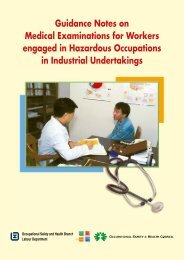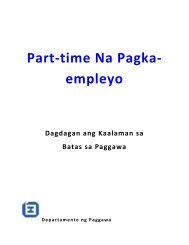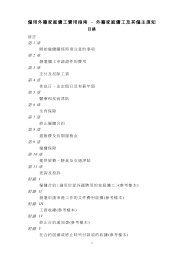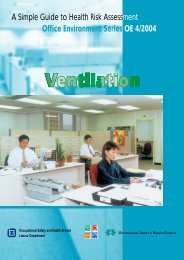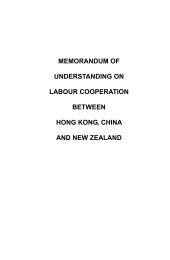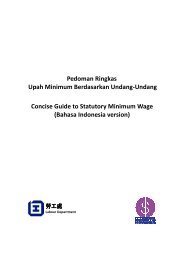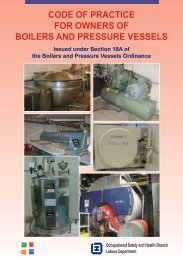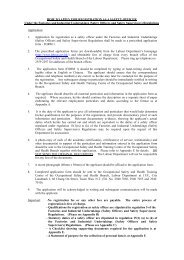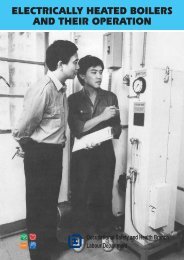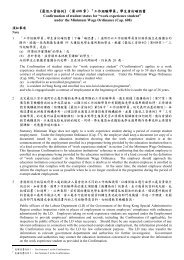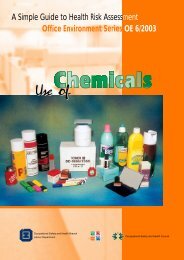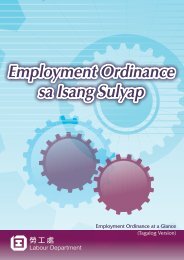Guidelines for Good Occupational Hygiene Practice in a
Guidelines for Good Occupational Hygiene Practice in a
Guidelines for Good Occupational Hygiene Practice in a
You also want an ePaper? Increase the reach of your titles
YUMPU automatically turns print PDFs into web optimized ePapers that Google loves.
This guidebook is prepared by the<br />
<strong>Occupational</strong> Safety and Health Branch<br />
Labour Department<br />
This edition June 2011<br />
This guidebook is issued free of charge and can be obta<strong>in</strong>ed from<br />
offices of the <strong>Occupational</strong> Safety and Health Branch of the<br />
Labour Department. It can also be downloaded from the Labour<br />
Department's website at http://www.labour.gov.hk. For enquiries<br />
about addresses and telephone numbers of the offices, please<br />
visit the above website or call 2559 2297.<br />
This guidebook may be freely reproduced except <strong>for</strong> advertis<strong>in</strong>g,<br />
endorsement or commercial purposes. Please acknowledge the source<br />
as "<strong>Guidel<strong>in</strong>es</strong> <strong>for</strong> <strong>Good</strong> <strong>Occupational</strong> <strong>Hygiene</strong> <strong>Practice</strong> <strong>in</strong> a<br />
Workplace", published by the Labour Department.
Preface<br />
The <strong>Occupational</strong> Safety & Health Ord<strong>in</strong>ance was enacted <strong>in</strong> May 1997 to provide <strong>for</strong> the safety<br />
and health protection of all employees at work. The <strong>Occupational</strong> Safety & Health Regulation<br />
made under the Ord<strong>in</strong>ance covers a wide range of basic health, safety and welfare matters as<br />
well as manual handl<strong>in</strong>g operations.<br />
To assist employers and employees <strong>in</strong> assess<strong>in</strong>g their own work environment, we have prepared<br />
this general booklet on good occupational hygiene practice. It should be read <strong>in</strong> conjunction<br />
with another booklet "Guidance Notes on Fire Safety at Workplaces" published also by this<br />
Department. For assessment of manual handl<strong>in</strong>g operations, please refer to the booklet "Guidance<br />
Notes on Manual Handl<strong>in</strong>g Operations".<br />
The law only stipulates the m<strong>in</strong>imum requirements <strong>for</strong> all workplaces. The general compliance<br />
standards referred to <strong>in</strong> this booklet should be applicable to most workplaces. For some trades<br />
which operate <strong>in</strong> rather unusual work<strong>in</strong>g environments, we will develop specific guidel<strong>in</strong>es to<br />
address their particular problems after a process of consultation.<br />
The language used <strong>in</strong> this booklet is deliberately kept simple and easy to understand. We s<strong>in</strong>cerely<br />
hope that both employers and employees can work together on the practical suggestions made <strong>in</strong><br />
this booklet, and <strong>in</strong>troduce improvements to the workplace where appropriate. A car<strong>in</strong>g<br />
employer's reward, we believe, is "<strong>Good</strong> Health Means <strong>Good</strong> Bus<strong>in</strong>ess"!<br />
<strong>Occupational</strong> Safety & Health Branch<br />
Labour Department<br />
23
24<br />
Contents<br />
Housekeep<strong>in</strong>g 1<br />
General ventilation 3<br />
Conta<strong>in</strong>ment and other<br />
means of eng<strong>in</strong>eer<strong>in</strong>g control 9<br />
Light<strong>in</strong>g 11<br />
Floors and dra<strong>in</strong>age 19<br />
Welfare facilities 20<br />
Equiries and Compla<strong>in</strong>ts 22
1_Housekeep<strong>in</strong>g<br />
<strong>Good</strong> housekeep<strong>in</strong>g means cleanl<strong>in</strong>ess and good order of equipment and facilities <strong>in</strong> a workplace. It<br />
needs plann<strong>in</strong>g and co-operation. Housekeep<strong>in</strong>g is the first step towards good occupational hygiene<br />
practice.<br />
A clean and tidy workplace<br />
is essential to ensure the<br />
health and safety of the<br />
workers.<br />
Cleanl<strong>in</strong>ess<br />
1.1_Cleanl<strong>in</strong>ess<br />
Regular clean<strong>in</strong>g of workplaces, equipment and devices should be carried out to ensure an adequate<br />
level of workplace hygiene. A designated person should be assigned the responsibility to oversee<br />
such operations.<br />
Rubbish or waste should be kept <strong>in</strong><br />
suitable conta<strong>in</strong>ers or litter-b<strong>in</strong>s<br />
which are located at convenient<br />
locations <strong>in</strong> the workplace. The<br />
conta<strong>in</strong>ers should be emptied daily,<br />
preferably near the end of each<br />
work<strong>in</strong>g day. Accumulation of dirt<br />
and refuse with<strong>in</strong> the workplaces<br />
must be avoided. They should be<br />
removed with a suitable method from<br />
Cleanl<strong>in</strong>ess<br />
The workplace should be cleaned accord<strong>in</strong>g to a<br />
schedule compatible with the tasks conducted.<br />
the floor or work benches regularly with a frequency compatible with the nature of the work<br />
conducted. Floor clean<strong>in</strong>g can be done by wash<strong>in</strong>g, sweep<strong>in</strong>g, vacuum clean<strong>in</strong>g or other<br />
appropriate means.<br />
Floor cover<strong>in</strong>g materials should be suitable <strong>for</strong> the work and easy to clean.<br />
The conditions of housekeep<strong>in</strong>g can be easily assessed by visual observations. Records of<br />
ma<strong>in</strong>tenance work must be kept <strong>for</strong> evaluation of the per<strong>for</strong>mance, <strong>in</strong>clud<strong>in</strong>g <strong>in</strong><strong>for</strong>mation<br />
on the responsible person(s), contact and date/time of the action taken.<br />
1
Tid<strong>in</strong>ess<br />
2<br />
1.2_Tid<strong>in</strong>ess<br />
Tid<strong>in</strong>ess improves work per<strong>for</strong>mance and reduces accident. Equipment, tools, conta<strong>in</strong>ers and<br />
small items on work benches should be kept neat and arranged <strong>in</strong> an orderly fashion. Sufficient<br />
space <strong>for</strong> storage of articles and goods is important.<br />
The tools and material should be<br />
kept neat and <strong>in</strong> an orderly<br />
fashion.<br />
1.3_Accident prevention<br />
The occurrence of accidents <strong>in</strong> a workplace could lead to damage to employees' health and <strong>in</strong><br />
severe cases death. Precautions must be taken when dangerous substances are stored or used.<br />
Conta<strong>in</strong>ers should be clearly labelled and the labels easily visible. Regular ma<strong>in</strong>tenance and<br />
check<strong>in</strong>g of the equipment and devices can reduce risks. The storage and disposal of chemicals<br />
or hazardous wastes should be done carefully. Accidental spillage and spread of waste or<br />
contam<strong>in</strong>ants can be avoided through proper assignment of duties, <strong>in</strong>struction, tra<strong>in</strong><strong>in</strong>g and good<br />
housekeep<strong>in</strong>g.<br />
Chemicals without proper labell<strong>in</strong>g may<br />
be misused and cause tragedy.<br />
A properly designed label provides<br />
readily available <strong>in</strong><strong>for</strong>mation which will<br />
prevent mishaps.
2_General ventilation<br />
Ventilation is the process of supply<strong>in</strong>g and remov<strong>in</strong>g air by natural or mechanical means to and from<br />
a workplace. The term "natural ventilation" covers both the uncontrolled <strong>in</strong>ward air leakage through<br />
cracks, w<strong>in</strong>dows, door ways and vents (<strong>in</strong>filtration) as well as the air leav<strong>in</strong>g the room (exfiltration)<br />
through the same routes. Infiltration and exfiltration are often affected by the weather and are beyond<br />
control.<br />
As a consequence, it is not feasible to rely upon natural ventilation to control emissions of dust and<br />
fumes. However, modest heat loads and very lowest emissions of gases and vapours could be effectively<br />
controlled by this system.<br />
Mechanical or <strong>for</strong>ced ventilation is provided by air movers or fans <strong>in</strong> a system such as a w<strong>in</strong>dowmounted<br />
exhaust fan. It promotes the supply as well as the exhaust airflow.<br />
Natural ventilation Induced dilution ventilation Forced dilution ventilation<br />
Dilution ventilation with air<br />
<strong>in</strong>-take and exhaust fans Air condition<strong>in</strong>g<br />
Different means of general ventilation<br />
3
4<br />
2.1_Provision of fresh air supply<br />
It is essential to ensure that adequate ventilation is provided to a workplace, especially <strong>in</strong> an<br />
enclosed build<strong>in</strong>g. General ventilation is designed to provide fresh air <strong>for</strong> breath<strong>in</strong>g by the<br />
occupants, control of thermal conditions and keep<strong>in</strong>g the air free from contam<strong>in</strong>ants (such as<br />
tobacco smoke, body odour and other air-borne contam<strong>in</strong>ants). The fresh air <strong>in</strong>take po<strong>in</strong>ts of a<br />
ventilation system should be away from any source of contam<strong>in</strong>ants. Filtration or clean<strong>in</strong>g of the<br />
<strong>in</strong>com<strong>in</strong>g air be<strong>for</strong>e be<strong>in</strong>g supplied to a workplace is recommended.<br />
In the plann<strong>in</strong>g stage of a build<strong>in</strong>g , the ventilation design should meet the m<strong>in</strong>imum requirements<br />
of the Build<strong>in</strong>g (Ventilat<strong>in</strong>g Systems) Regulations. The Labour Department has also published<br />
a booklet called "Guidance Notes on Ventilation & Ma<strong>in</strong>tenance of Ventilation Systems" from<br />
which employers and employees can also f<strong>in</strong>d useful <strong>in</strong><strong>for</strong>mation <strong>for</strong> design of a work process<br />
and improvement of their ventilation system.<br />
Regardless of the type of ventilation used, sufficient fresh<br />
air must be supplied.<br />
The fresh air supply rate required <strong>for</strong> a workplace varies<br />
with the nature of the activities and the degree of<br />
occupancy. Recommendations of fresh air supply rate <strong>for</strong><br />
certa<strong>in</strong> activities are given <strong>in</strong> the follow<strong>in</strong>g tables.<br />
Fresh air supply rate <strong>for</strong> general work activities <strong>in</strong> air-conditioned workplaces<br />
(A) For places where the number of persons present is normally constant.<br />
Types of work activity<br />
Open plan offices (nonsmok<strong>in</strong>g<br />
), classrooms <strong>in</strong> schools<br />
Private offices ( with moderate<br />
smok<strong>in</strong>g ), laboratories<br />
Conference rooms or offices<br />
(with heavy smok<strong>in</strong>g )<br />
Canteens, restaurants<br />
M<strong>in</strong>imum fresh air<br />
3<br />
supply rate (m /m<strong>in</strong>/person)<br />
0.43<br />
0.6<br />
1.0<br />
0.3<br />
(based on the seat<strong>in</strong>g capacity<br />
and the number of employees)<br />
Remark<br />
The normal daily work<strong>in</strong>g hours or<br />
hours of stay are long e.g. 8 hours<br />
On average , people may not stay <strong>in</strong> the<br />
area <strong>for</strong> a long period
(B) For places where the number of persons may vary from time to time.<br />
Types of work activity<br />
Shops, supermarkets, department<br />
stores<br />
Kitchen ( Restaurants)<br />
M<strong>in</strong>imum fresh air<br />
supply rate (m /m floor area/m<strong>in</strong>)<br />
0.18<br />
1.2<br />
3<br />
Remark<br />
Generally no smok<strong>in</strong>g<br />
Additional exhaust <strong>for</strong> work<strong>in</strong>g areas<br />
is required<br />
Note: Local exhaust should be provided if harmful substances are generated.<br />
2.2_Ma<strong>in</strong>tenance<br />
If a mechanical ventilation system is used, regular checks (e.g. annually) should be carried<br />
out to reveal malfunctions and prevent breakdowns.<br />
Visible deposit or dirt on the fans and duct work system is likely to cause health risks and<br />
should be removed.<br />
2.3_Monitor<strong>in</strong>g of the ventilation system<br />
2<br />
Ventilation duct<strong>in</strong>g should be<br />
cleaned regularly.<br />
Regular clean<strong>in</strong>g of the<br />
filters, fans and cool<strong>in</strong>g<br />
coils of a ventilation<br />
system is essential to<br />
ensure efficiency and the<br />
occupants' health.<br />
In a workplace without a specific source of contam<strong>in</strong>ation, the adequacy of ventilation can be<br />
measured <strong>in</strong>directly with a carbon dioxide <strong>in</strong>dex method. As the concentration of carbon dioxide<br />
<strong>in</strong>crease with human activities, background levels of other contam<strong>in</strong>ants also <strong>in</strong>crease. Carbon<br />
dioxide level frequently exceed<strong>in</strong>g 1000 ppm (although carbon dioxide at such level is not a<br />
health concern) could be a useful <strong>in</strong>dicator <strong>for</strong> review of the fresh air supply rate, distribution and<br />
the activities go<strong>in</strong>g on, especially when there is a compla<strong>in</strong>t.<br />
5
6<br />
Methodology<br />
Carbon dioxide can be measured with either a direct-read<strong>in</strong>g meter or detector tube kit. The relative<br />
occupancy, air damper sett<strong>in</strong>g and weather should be noted <strong>for</strong> each period of carbon dioxide measurement.<br />
The measurement should be made when concentration are expected to peak. If the occupant population<br />
is fairly stable dur<strong>in</strong>g normal bus<strong>in</strong>ess hours, carbon dioxide levels will typically rise dur<strong>in</strong>g the morn<strong>in</strong>g,<br />
fall dur<strong>in</strong>g the lunch period, then rise aga<strong>in</strong>, reach<strong>in</strong>g a peak <strong>in</strong> mid afternoon. In this case, sampl<strong>in</strong>g <strong>in</strong><br />
the mid- to late-afternoon is recommended. It is helpful to compare measurement taken at different<br />
times of a day. Other sampl<strong>in</strong>g times may be necessary <strong>for</strong> different occupancy schedules. Individual<br />
measurements may be short-term .<br />
It is advisable to take one or more read<strong>in</strong>gs <strong>in</strong> "control" locations to serve as basel<strong>in</strong>e <strong>for</strong> comparison.<br />
Read<strong>in</strong>gs from outdoors and from areas <strong>in</strong> which there are no apparent IAQ problems are frequently<br />
used as controls. Outdoor samples should be taken near the outdoor air <strong>in</strong>take.<br />
Precautions <strong>in</strong> tak<strong>in</strong>g the measurement<br />
measured away from any source that could directly <strong>in</strong>fluence the read<strong>in</strong>g (e.g., hold<br />
the sampl<strong>in</strong>g device away from exhaled breath).<br />
preferably measured at head height.<br />
The adequacy of ventilation should be<br />
monitored by check<strong>in</strong>g the carbon dioxide<br />
level <strong>in</strong> the workplace.<br />
2.4_Thermal conditions<br />
Thermal conditions <strong>for</strong> enclosed workplaces should be commensurate with the activities <strong>in</strong> the<br />
area. The factors affect<strong>in</strong>g these conditions <strong>in</strong>clude air temperature, humidity and air movement.<br />
In naturally ventilated workplaces, <strong>for</strong> the best productivity and relative com<strong>for</strong>t, the optimum<br />
effective temperature (footnote) is below 27 . For workplaces where room temperature<br />
control is difficult and where the effective temperature is likely to significantly exceed the<br />
recommended value, heat stress problems are likely and should be assessed. When<br />
cont<strong>in</strong>uous strenuous work is required to be carried out <strong>in</strong> a hot environment, other<br />
improvements should also be considered, <strong>in</strong>clud<strong>in</strong>g <strong>for</strong> example, suitable cloth<strong>in</strong>g, activity<br />
break period, supply of dr<strong>in</strong>k<strong>in</strong>g water etc.<br />
In an <strong>in</strong>door work environment, the lower air temperature is preferably ma<strong>in</strong>ta<strong>in</strong>ed at 16<br />
or above.<br />
Footnote : Effective temperature is not a read<strong>in</strong>g on a thermometer <strong>in</strong> a particular environment. It is an <strong>in</strong>dex of<br />
relative com<strong>for</strong>t compiled with reference to the effects of air temperature, relative humidity and air movement<br />
on a group of tested subjects (people). The reference to 27 =is recommended by the "American Society<br />
of Heat<strong>in</strong>g, Refrigeration and Air Condition<strong>in</strong>g Eng<strong>in</strong>eers".
For air-conditioned workplaces, when the range of room temperature <strong>for</strong> normal activities<br />
can be ma<strong>in</strong>ta<strong>in</strong>ed between 20 - 26 , and relative humidity between 40% and 70%, the<br />
conditions are usually satisfactory. It provides optimum com<strong>for</strong>t and restricts the growth of<br />
micro-organisms. The upper temperature range of 23 - 26 is preferable <strong>for</strong> summer<br />
and the lower temperature range of 20 - 24 is <strong>for</strong> w<strong>in</strong>ter. Supply of fresh air to an airconditioned<br />
area is particularly important as most of the <strong>in</strong>door air is be<strong>in</strong>g re-circulated<br />
through the system. Ma<strong>in</strong>tenance of the system is also required because it often becomes<br />
the source of contam<strong>in</strong>ation when not properly ma<strong>in</strong>ta<strong>in</strong>ed.<br />
The <strong>in</strong>stallation of artificial ventilation should not expose employees to draughts which<br />
may cause discom<strong>for</strong>t. Similar problem may occur when the pressure among workrooms<br />
are not well balanced.<br />
A central air condition<strong>in</strong>g system<br />
should be well-balanced and cause no<br />
draught to the occupants, otherwise the<br />
system will be tempered, thus caus<strong>in</strong>g<br />
further problem.<br />
2.5_Air quality standard <strong>for</strong> chemical contam<strong>in</strong>ants<br />
The general ventilation provided <strong>for</strong> the normal work environment should be able to keep the air<br />
free from chemical and biological impurities <strong>for</strong> protection of employees' health. The Labour<br />
Department has published a booklet called "A Reference Note on <strong>Occupational</strong> Exposure Limits<br />
<strong>for</strong> Chemical Substances <strong>in</strong> the Work Environment", which conta<strong>in</strong>s useful <strong>in</strong><strong>for</strong>mation on<br />
workplace air quality standards.<br />
To ensure good air quality, no visible dust, fume or mist should be found <strong>in</strong> the workplace,<br />
nor should odour be present that can cause acute discom<strong>for</strong>t and irritation to the employees.<br />
For specific sources of air-borne contam<strong>in</strong>ants (e.g. from an <strong>in</strong>dustrial process), employers<br />
should take all reasonably practicable measures to control the air-borne contam<strong>in</strong>ants with<strong>in</strong><br />
an acceptable level.<br />
7
8<br />
In dangerous operations, a risk assessment programme should be scheduled to spot out if<br />
any malpractice or specific sources of air-borne contam<strong>in</strong>ants occur <strong>in</strong> the workplace. Risk<br />
assessment should be carried out when there is<br />
a new process or a change <strong>in</strong> the process. If any<br />
significant health risk has been identified,<br />
employers must take immediate corrective<br />
actions or seek further advice from a competent<br />
person.<br />
Cont<strong>in</strong>uous or regular monitor<strong>in</strong>g of air quality<br />
may be required if the levels of impurities cannot<br />
be kept well with<strong>in</strong> or have already exceeded<br />
the recommended occupational exposure limits.<br />
Effective control measures should be considered<br />
<strong>for</strong> improvement of the work environment.<br />
A great variety of techniques and <strong>in</strong>strument are available <strong>for</strong> monitor<strong>in</strong>g dust, mist, vapour and<br />
gas <strong>in</strong> air. A specialist may be required to per<strong>for</strong>m the monitor<strong>in</strong>g <strong>in</strong> some cases.<br />
2.6_Control of biological contam<strong>in</strong>ants<br />
In practical terms, employers have a duty to undertake proper house-keep<strong>in</strong>g to avoid<br />
biological contam<strong>in</strong>ation and mould/bacteria growth <strong>in</strong>side build<strong>in</strong>gs. The proper<br />
ma<strong>in</strong>tenance of the air-condition<strong>in</strong>g system and fresh air supply can remove unpleasant<br />
odour and may prevent air-borne diseases. The “Code of <strong>Practice</strong> on Prevention of<br />
Legionnaires’ Disease” published by the Electrical & Mechanical Services Department gives<br />
the necessary guidel<strong>in</strong>es <strong>for</strong> the employer to follow <strong>in</strong> the proper ma<strong>in</strong>tenance of aircondition<strong>in</strong>g<br />
systems, cool<strong>in</strong>g towers and centralised hot water supply systems.<br />
For cl<strong>in</strong>ics, hospitals and health care <strong>in</strong>stitutions, there should be additional requirements<br />
<strong>for</strong> proper disposal of cl<strong>in</strong>ical wastes and adequate<br />
facilities, and proper systems <strong>for</strong> control of<br />
biological contam<strong>in</strong>ants. In some situations, the<br />
employer or management should have an operat<strong>in</strong>g<br />
manual so that his employees can follow the<br />
<strong>in</strong>structions carefully.<br />
Water cool<strong>in</strong>g towers must be<br />
regularly dis<strong>in</strong>fected.
3_Conta<strong>in</strong>ment and other means of eng<strong>in</strong>eer<strong>in</strong>g control<br />
In the case of activities that cause exposure to air-borne contam<strong>in</strong>ants, special control measures or<br />
facilities should be considered. Such measures would be useful <strong>in</strong> protect<strong>in</strong>g employees from <strong>in</strong>halation<br />
of air-borne impurities and <strong>in</strong> avoid<strong>in</strong>g accumulation of harmful substances <strong>in</strong> the work environment.<br />
3.1_Full conta<strong>in</strong>ment method<br />
This can prevent the spread of contam<strong>in</strong>ation and accumulation of impurities <strong>in</strong> a workplace.<br />
A fully enclosed glove box<br />
can be used <strong>for</strong> sand<br />
blast<strong>in</strong>g or process<strong>in</strong>g<br />
highly toxic substances.<br />
3.2_Physical barriers<br />
Pa<strong>in</strong>t spray<strong>in</strong>g should be conducted <strong>in</strong> a spray<strong>in</strong>g<br />
room with <strong>in</strong>dependent ventilation system so as not<br />
to affect the other workers.<br />
Hazardous operations (e.g. a pr<strong>in</strong>t<strong>in</strong>g job be<strong>in</strong>g done <strong>in</strong> an office) should be separated from other<br />
activities by physical barriers partially or completely to prevent the spread and accumulation of<br />
air-borne contam<strong>in</strong>ants <strong>in</strong>to the normal work<strong>in</strong>g area. Other means of control should be provided<br />
<strong>in</strong> the (pr<strong>in</strong>t<strong>in</strong>g) area <strong>for</strong> the protection of the employees.<br />
3.3_Mechanical ventilation<br />
To prevent accumulation of air-borne contam<strong>in</strong>ants <strong>in</strong> the work area, mechanical exhaust ventilation<br />
is required to remove the impurities <strong>in</strong> air and to discharge them properly. Sufficient make-up air<br />
should be provided to facilitate the removal of contam<strong>in</strong>ated air.<br />
Exhaust ventilation should be arranged <strong>in</strong> such<br />
a way that cross ventilation is achieved and<br />
contam<strong>in</strong>ants are blown away from the<br />
workers.<br />
9
10<br />
3.4_Local exhaust ventilation<br />
In specially hazardous operations, a local exhaust system may be required to effectively control<br />
atmospheric contam<strong>in</strong>ation at its source. A local exhaust system should normally conta<strong>in</strong> an<br />
enclos<strong>in</strong>g hood, duct<strong>in</strong>g, an air cleaner and an exhaust fan.<br />
Local<br />
Exhaust<br />
Ventilation<br />
To ensure effective control, the hood open<strong>in</strong>g should be <strong>in</strong>stalled and used as close as<br />
reasonably practicable to the source of contam<strong>in</strong>ants. The arrangement of position<strong>in</strong>g the<br />
hood so that it can enclose or conf<strong>in</strong>e the contam<strong>in</strong>ant is recommended.<br />
If <strong>in</strong>stallation of a fixed local exhaust<br />
system is not feasible, a mobile system<br />
with a suitable filter should be<br />
considered.<br />
A local exhaust hood should enclose the source<br />
of contam<strong>in</strong>ation as far as practicable.
4_Light<strong>in</strong>g<br />
It is essential <strong>for</strong> employees to work and move around safely <strong>in</strong> a workplace. Natural light<strong>in</strong>g is<br />
preferable but due to its unreliable nature and many other uncontrollable factors like sky brightness,<br />
seasonal variation, distance from w<strong>in</strong>dows and limited w<strong>in</strong>dow area, etc., artificial light<strong>in</strong>g is often<br />
used as a supplement to daylight. Modern <strong>in</strong>door work environment relies very heavily on artificial<br />
light<strong>in</strong>g. Artificial light<strong>in</strong>g so provided should enable employees to see the visual task with ease and<br />
improve accuracy <strong>for</strong> better per<strong>for</strong>mance. The appearance, colour and details of the <strong>in</strong>terior can also<br />
be enhanced through appropriate light<strong>in</strong>g.<br />
4.1_Daylight<br />
Daylight is the best and cheapest source of illum<strong>in</strong>ation. It can reduce energy costs but should be<br />
planned <strong>in</strong> the early stage of build<strong>in</strong>g design to maximize its application (Please refer also to the<br />
Build<strong>in</strong>g (Plann<strong>in</strong>g) Regulations <strong>for</strong> the m<strong>in</strong>imum requirements). Mak<strong>in</strong>g improvements <strong>in</strong> the<br />
later stage may be costly.<br />
The distribution of light <strong>in</strong> a workplace can be improved by us<strong>in</strong>g more daylight. To get more<br />
daylight, people may rearrange their work orientation or the location of mach<strong>in</strong>es, or <strong>in</strong>crease<br />
the size of w<strong>in</strong>dows or have w<strong>in</strong>dows placed higher up to take advantage of more daylight.<br />
W<strong>in</strong>dows and open<strong>in</strong>gs may be protected from direct sunlight by curta<strong>in</strong>s or bl<strong>in</strong>ds to<br />
avoid glare and direct heat from the sun.<br />
The use of artificial light and natural light is<br />
complementary. Their comb<strong>in</strong>ed use is most<br />
economical and effective. It creates a sense of<br />
openness.<br />
4.2_Light<strong>in</strong>g provision<br />
Bl<strong>in</strong>ds or curta<strong>in</strong>s should be used to control<br />
direct sunlight and to avoid glare.<br />
In workplaces, the artificial light<strong>in</strong>g provided should be such that there is no risk of accident to all<br />
employees (too dim), nor should it be damag<strong>in</strong>g to their eyesight such as caus<strong>in</strong>g glare (too<br />
bright) or visual fatigue. The recommendations of illum<strong>in</strong>ance <strong>for</strong> general activities are given <strong>in</strong><br />
paragraph 4.6 below.<br />
11
12<br />
When the <strong>in</strong>tensity of light<strong>in</strong>g <strong>in</strong> a workplace is <strong>in</strong>sufficient, the first consideration on<br />
improvement is to use light colours <strong>for</strong> walls and ceil<strong>in</strong>gs to <strong>in</strong>crease the amount of reflected<br />
light. A white surface can have over 80% - 90% reflectivity. A pale t<strong>in</strong>t <strong>for</strong> walls can have<br />
reflectivity up to 50 - 85%.<br />
Sufficient light<strong>in</strong>g improves employees com<strong>for</strong>t and per<strong>for</strong>mance. Comb<strong>in</strong><strong>in</strong>g the use of<br />
natural light and artificial light<strong>in</strong>g is the best mode.<br />
Old people need more light. For example, an employee aged 60 needs five times more<br />
light to read a pr<strong>in</strong>ted text than a 20-year-old one.<br />
The time available <strong>for</strong> view<strong>in</strong>g the task<br />
affects the requirement of light<strong>in</strong>g too.<br />
The higher the speed of the task is, the<br />
higher the light<strong>in</strong>g level should be. Local<br />
light<strong>in</strong>g is recommended <strong>for</strong> precision or<br />
<strong>in</strong>spection work. Local lights that are<br />
easy to move and arrange <strong>in</strong> the desired<br />
positions are recommended.<br />
4.3_Glare effect<br />
Disability glare from a light<br />
fitt<strong>in</strong>g.<br />
Task lamp should be provided to illum<strong>in</strong>ate the<br />
work surface if a higher level of local light<strong>in</strong>g is<br />
required.<br />
Glare effect can cause discom<strong>for</strong>t (often from reflective surfaces) and reduced visibility (often<br />
from a broad band source of white light perceived when fac<strong>in</strong>g a w<strong>in</strong>dow). It reduces the ability<br />
to see and should be elim<strong>in</strong>ated. A com<strong>for</strong>table workplace should have no glare.<br />
Disability glare from w<strong>in</strong>dows.<br />
Glossy or sh<strong>in</strong>y materials or pa<strong>in</strong>t <strong>for</strong> wall and surfaces should be avoided to prevent <strong>in</strong>direct<br />
glare.
4.4_Contrast<br />
Sometimes, the desk top may reflect the light<br />
sources at the ceil<strong>in</strong>g or at the front to the<br />
users. To avoid the <strong>in</strong>direct glare effect, you<br />
may have to re-arrange the position of the<br />
work station or relocate light sources or<br />
provide shields to elim<strong>in</strong>ate the problem.<br />
Distraction reflection close to the l<strong>in</strong>e of sight.<br />
Direct glare can be removed by avoid<strong>in</strong>g bright light sources fall<strong>in</strong>g with<strong>in</strong> the normal field<br />
of vision. Mount<strong>in</strong>g local lights high enough and shad<strong>in</strong>g them well to hide all bulbs can<br />
improve the situation. The use of naked light bulbs or fluorescent tubes is not recommended.<br />
The glare effect from w<strong>in</strong>dows or neighbour<strong>in</strong>g work stations can affect visibility. It can be<br />
prevented by us<strong>in</strong>g curta<strong>in</strong>s, bl<strong>in</strong>ds, partitions or desk-top partitions.<br />
Light<strong>in</strong>g provision at higher positions gives better dispersion and prevents glare.<br />
Older people are more sensitive to glare. They often need better light<strong>in</strong>g arrangements.<br />
Chang<strong>in</strong>g the view from a bright area to a dark area demands adaption of the eyes. It takes time<br />
and is often tir<strong>in</strong>g if the difference (contrast) is significant. It is recommended that the contrast<br />
between the job (target) and the immediate background should be no more than 10:3, and that<br />
between the target and its surround<strong>in</strong>g environment should be no more than 10:1.<br />
The workplace should be lit up gently and evenly to m<strong>in</strong>imize changes <strong>in</strong> brightness. Sharp<br />
shadows on the work surface are a reason <strong>for</strong> poor per<strong>for</strong>mance, eye stra<strong>in</strong>, fatigue and<br />
sometimes accidents. Shadow zones should be elim<strong>in</strong>ated by provid<strong>in</strong>g good distribution<br />
of lights as well as enhanc<strong>in</strong>g reflection from the walls and the ceil<strong>in</strong>g.<br />
In case there is a bright light source fall<strong>in</strong>g with<strong>in</strong> the normal field of vision, the contrast<br />
can be reduced by provid<strong>in</strong>g more light <strong>for</strong> the environment.<br />
13
14<br />
Large difference <strong>in</strong> light<strong>in</strong>g level between<br />
adjacent area may cause visual<br />
discom<strong>for</strong>t or even affect safety <strong>in</strong> places<br />
where there is frequent movement.<br />
4.5_Flicker<br />
Flicker<strong>in</strong>g is also a possible cause lead<strong>in</strong>g to eye fatigue. The<br />
effect is usually related to the lights or other mechanical means<br />
(such as the mov<strong>in</strong>g blades of a ceil<strong>in</strong>g fan underneath a lamp).<br />
It should be elim<strong>in</strong>ated.<br />
All types of lights could <strong>in</strong>duce the flicker<strong>in</strong>g effect due to<br />
the use of alternat<strong>in</strong>g current. The effect can be suppressed<br />
by replac<strong>in</strong>g worn-out fluorescent lamps. If necessary,<br />
use filament bulbs <strong>in</strong>stead.<br />
Elim<strong>in</strong>ate all possible flickers.<br />
Flicker<br />
The illum<strong>in</strong>ation of the target should be higher than<br />
the surround<strong>in</strong>g and falls gradually outwards. The<br />
maximum ratio of lum<strong>in</strong>ance should not exceed 10:3:1<br />
(target : immediate background : surround<strong>in</strong>g).<br />
Worn-out fluorescent tube is<br />
a common source of flicker.
4.6_Recommendations of illum<strong>in</strong>ance <strong>for</strong> general activities<br />
The follow<strong>in</strong>g table gives examples of optimum levels of light<strong>in</strong>g <strong>for</strong> a wide range of activities/areas.<br />
Item Task position or area<br />
1_OFFICES<br />
2_BANKS<br />
Optimum average<br />
illum<strong>in</strong>ation <strong>in</strong> lux<br />
General offices 500<br />
Notes<br />
Computer work stations 500 Local light<strong>in</strong>g may be required <strong>for</strong><br />
read<strong>in</strong>g a document<br />
Draw<strong>in</strong>g work stations 750 Local light<strong>in</strong>g is appropriate<br />
Other areas, e.g. file storage<br />
and reception, telephone<br />
operators<br />
Counter, office area 500<br />
Public area 300<br />
3_SHOPS & SUPERMARKETS<br />
General 500 Illum<strong>in</strong>at<strong>in</strong>g the vertical surfaces<br />
of the display is required<br />
300<br />
Counter 500<br />
4_LIBRARIES<br />
General 300<br />
Counter, book repair, sort<strong>in</strong>g 500<br />
Bookshelves 150 Illum<strong>in</strong>at<strong>in</strong>g the vertical faces at the<br />
bottom of bookstack is required<br />
Read<strong>in</strong>g tables<br />
5_SCHOOLS<br />
300 Local light<strong>in</strong>g may be appropriate<br />
Classrooms , laboratories 500<br />
Artrooms needlework rooms 500 Supplementary local light<strong>in</strong>g is<br />
desirable<br />
Music rooms, sports halls 300<br />
Workshops 300 Supplemeantary local light<strong>in</strong>g is<br />
desirable<br />
15
16<br />
Item Task position or area<br />
Optimum average<br />
illum<strong>in</strong>ation <strong>in</strong> lux<br />
6_MANUFACTURING AND PROCESSING AREAS<br />
Major control rooms 500<br />
Handl<strong>in</strong>g of hazardous<br />
substances<br />
Handl<strong>in</strong>g of substances which<br />
are not hazardous<br />
500<br />
200<br />
Automatic processes 200<br />
Simple assembly, rough bench,<br />
mach<strong>in</strong>e and <strong>in</strong>spection work;<br />
e.g. heavy mach<strong>in</strong>ery assembly<br />
Medium assembly, bench,<br />
mach<strong>in</strong>e and <strong>in</strong>spection work;<br />
e.g. vehicle body assembly<br />
Assembly of precision<br />
components, f<strong>in</strong>e bench,<br />
mach<strong>in</strong>e and <strong>in</strong>spection work;<br />
e.g. <strong>in</strong>sertion of electronic<br />
components, <strong>in</strong>spection of<br />
PCBs<br />
Assembly of high precision<br />
parts, very f<strong>in</strong>e <strong>in</strong>spection<br />
work; e.g. cloth<strong>in</strong>g <strong>in</strong>spection,<br />
watch mak<strong>in</strong>g<br />
7_DISTRIBUTION AND STORAGE<br />
300<br />
Special lum<strong>in</strong>aires are desirable if<br />
corrosive or explosive atmosphere<br />
may be present<br />
500 Local light<strong>in</strong>g may be appropriate<br />
1000<br />
1500<br />
Load<strong>in</strong>g bays 150<br />
Unpack<strong>in</strong>g, sort<strong>in</strong>g 200<br />
Local light<strong>in</strong>g is desirable. Care is<br />
necessary to control specular<br />
reflections<br />
Local light<strong>in</strong>g is desirable. Care is<br />
necessary to control specular<br />
reflections<br />
Large item storage 100 Supplementary local light<strong>in</strong>g may be<br />
necessary if identification requires<br />
perception of detail<br />
Small item rack storage 300 Supplementary local light<strong>in</strong>g may be<br />
necessary if identification is visually<br />
difficult<br />
Issue counter, storeman's desks 500 Local light<strong>in</strong>g may be appropriate<br />
Pack<strong>in</strong>g and despatch 300<br />
Notes
Item Task position or area<br />
8_CATERING SERVICES<br />
Vegetable preparation,<br />
wash<strong>in</strong>g up areas, food<br />
distribution<br />
300<br />
Food preparation and cook<strong>in</strong>g 500<br />
Food stores and cellars 150<br />
9_GENERAL BUILDING AREAS<br />
Entrances, lobbies, wait<strong>in</strong>g<br />
rooms, gatehouses<br />
200<br />
Care should be taken to avoid a<br />
sudden change of illum<strong>in</strong>ance<br />
between <strong>in</strong>side and outside<br />
Enquiry desks 500 Localised light<strong>in</strong>g may be<br />
appropriate<br />
Corridors, passageways,<br />
stairs, lifts<br />
Boiler rooms, mechanical<br />
plant rooms, electrical power<br />
supply and distribution rooms<br />
100<br />
200<br />
Covered car parks 50<br />
Outdoor car parks 10<br />
Emergency equipment<br />
locations<br />
Emergency light<strong>in</strong>g 10 Operate automatically when<br />
normal power supply fails<br />
10_CONSTRUCTION SITE<br />
Site clearance, excavation and<br />
soil work<br />
Optimum average<br />
illum<strong>in</strong>ation <strong>in</strong> lux<br />
50<br />
200<br />
Notes<br />
Portable local light<strong>in</strong>g may be<br />
needed<br />
Note: M<strong>in</strong>imum Levels of Light<strong>in</strong>g—<br />
(a) For Item 1–8, the measured average levels of light<strong>in</strong>g at a task position or <strong>in</strong> an area<br />
should not be less than 1/3 of the optimum average illum<strong>in</strong>ation.<br />
(b) For Item 9–10, the measured average levels of light<strong>in</strong>g at a task position or <strong>in</strong> an area<br />
should not be less than 1/10 of the optimum average illum<strong>in</strong>ation.<br />
Reference: 1. Chartered Institution of Build<strong>in</strong>g Services Eng<strong>in</strong>eers (CIBSE), Code <strong>for</strong> Interior Light<strong>in</strong>g,<br />
London, 1994.<br />
2. Canada <strong>Occupational</strong> Health and Safety Regulaitons, Part VI.<br />
17
18<br />
4.7_Measurement of average levels of light<strong>in</strong>g<br />
The method relies upon a grid of measur<strong>in</strong>g po<strong>in</strong>ts over the whole area under consideration, i.e.<br />
the area is divided <strong>in</strong>to a number of equal squares. The illum<strong>in</strong>ance at the centre of each of the<br />
squares is measured at desk top height (typically 0.85 m above floor level) and an average value<br />
of illum<strong>in</strong>ance is calculated.<br />
Light<strong>in</strong>g levels <strong>in</strong> a workplace can be measured<br />
with a light meter.<br />
4.8_Ma<strong>in</strong>tenance programme<br />
Light<strong>in</strong>g conditions <strong>in</strong> workplaces should be <strong>in</strong>spected regularly with a planned walk-through<br />
survey to f<strong>in</strong>d out if there is any fault and/or malfunction of equipment. Worn-out light<strong>in</strong>g devices<br />
should be replaced. A ma<strong>in</strong>tenance programme should <strong>in</strong>clude clean<strong>in</strong>g of lamps, fixtures and<br />
reflectors, as well as w<strong>in</strong>dows, ceil<strong>in</strong>gs, walls and other <strong>in</strong>terior surfaces. The efficiency of the<br />
lights can be improved by more than 20% after clean<strong>in</strong>g.<br />
Scheduled replacement of all lamps at<br />
the end of the expected service life is<br />
recommended. The overall light<strong>in</strong>g level<br />
can be kept more constant.
5_Floors and dra<strong>in</strong>age<br />
Some activities <strong>in</strong> a workplace are liable to make the floors or wall surfaces wet. An effective dra<strong>in</strong>age<br />
system should be provided so that water can be removed and dra<strong>in</strong>ed quickly from the floor. This<br />
prevents the floor from caus<strong>in</strong>g slips and accidents, and reduces the flourish<strong>in</strong>g growth of mould and<br />
other micro-organisms.<br />
5.1_Floor condition<br />
The floor should be ma<strong>in</strong>ta<strong>in</strong>ed clean, stable and non-slippery. For workplaces where wett<strong>in</strong>g of<br />
the floor is unavoidable, the tiles should be made of non-slippery material. Alternatively, a foot<br />
plat<strong>for</strong>m may be provided <strong>for</strong> employees to stay away from the wet surface. Moreover, the<br />
dra<strong>in</strong>age should be well ma<strong>in</strong>ta<strong>in</strong>ed and under no circumstances should dirt be allowed to<br />
accumulate underneath the plat<strong>for</strong>m or the corners of the shop floor.<br />
The floor of a workplace should always be<br />
ma<strong>in</strong>ta<strong>in</strong>ed clean, stable and non-slippery.<br />
5.2_Inspection<br />
A rais<strong>in</strong>g plat<strong>for</strong>m should be provided where wett<strong>in</strong>g<br />
of the floor is unavoidable, e.g. <strong>in</strong> an electroplat<strong>in</strong>g<br />
factory.<br />
Visual <strong>in</strong>spection of workplaces to note down the conditions and spot out malpractice would be<br />
required. The records of malpractice must be followed up to ensure remedial action has been<br />
taken.<br />
Inspection<br />
19
20<br />
6_Welfare facilities<br />
6.1_Lavatories and wash<strong>in</strong>g facilities<br />
Suitable and sufficient sanitary conveniences and wash bas<strong>in</strong>s should be provided at readily<br />
accessible places. They are supposed to be adjacent to but separate from other sanitary facilities<br />
such as chang<strong>in</strong>g rooms and shower facilities.<br />
Sufficient sanitary facilities<br />
should be provided <strong>for</strong> uses by<br />
employees <strong>in</strong> a workplace.<br />
They should always be<br />
ma<strong>in</strong>ta<strong>in</strong>ed clean and hygienic.<br />
Sanitary facilities should be provided <strong>for</strong> men and<br />
women separately.<br />
The facilities must be ma<strong>in</strong>ta<strong>in</strong>ed tidy, clean and<br />
hygienic. Daily clean<strong>in</strong>g is recommended.<br />
The number of water closets and related facilities <strong>for</strong> employees should follow the<br />
recommendations <strong>in</strong> the Build<strong>in</strong>g (Standards of Sanitary Fitments, Plumb<strong>in</strong>g, Dra<strong>in</strong>age<br />
Works and Latr<strong>in</strong>es) Regulations under Hong Kong Laws, Chapter 123.<br />
The conditions of cleanl<strong>in</strong>ess of the sanitary facilities should be <strong>in</strong>spected regularly (e.g.<br />
weekly) by an appo<strong>in</strong>ted personnel. Breakdowns of the units, blockage of the pipes or<br />
leakage should be reported immediately <strong>for</strong> repair. The records should be counter-checked<br />
and signed by the management or a responsible person.<br />
6.2_Chang<strong>in</strong>g rooms and shower facilities<br />
When the activities <strong>in</strong> the workplace are likely to produce bodily contam<strong>in</strong>ation, an adequate,<br />
suitable and secure place should be provided <strong>for</strong> employees to store their own cloth<strong>in</strong>g and work<br />
cloth<strong>in</strong>g.<br />
Chang<strong>in</strong>g rooms should be equipped with lockers. To ma<strong>in</strong>ta<strong>in</strong> good personal hygiene,<br />
showers with hot and cold or warm water supply are required and should be readily accessible<br />
from workrooms.
When a highly dangerous operation is carried out <strong>in</strong> a workplace, an emergency shower or<br />
eye-washers should be provided at suitable locations. All the facilities should be properly<br />
ma<strong>in</strong>ta<strong>in</strong>ed and be kept sanitary <strong>for</strong> use <strong>in</strong> emergency<br />
situations.<br />
Dirty work cloth<strong>in</strong>g should not<br />
be mixed with personal<br />
cloth<strong>in</strong>g <strong>in</strong> a chang<strong>in</strong>g room.<br />
They should be properly<br />
bagged <strong>for</strong> laundry.<br />
6.3_Dr<strong>in</strong>k<strong>in</strong>g water supply<br />
Emergency showers and eye washers should be<br />
provided <strong>in</strong> areas where accidental contact of the<br />
body with dangerous chemicals is possible.<br />
Employers have a duty to provide an adequate supply of dr<strong>in</strong>k<strong>in</strong>g water. <strong>Good</strong> dr<strong>in</strong>k<strong>in</strong>g facilities<br />
and rest places can do much to prevent fatigue and to ma<strong>in</strong>ta<strong>in</strong> employees' health. It is especially<br />
important <strong>in</strong> a hot environment.<br />
The supply of dr<strong>in</strong>k<strong>in</strong>g water facilities or wholesome dr<strong>in</strong>k<strong>in</strong>g water such as tap water or<br />
dr<strong>in</strong>k<strong>in</strong>g founta<strong>in</strong>s should be easy to access. However, such facilities should not be near<br />
dangerous mach<strong>in</strong>es nor contam<strong>in</strong>ation sources, nor <strong>in</strong> washrooms or toilets.<br />
Bottled dr<strong>in</strong>k<strong>in</strong>g water or other beverages can be alternatives to dr<strong>in</strong>k<strong>in</strong>g water facilities.<br />
They are hygienic and require the least<br />
ma<strong>in</strong>tenance.<br />
In a hot environment or summer, it is<br />
important to provide cool water. If there is<br />
no water cool<strong>in</strong>g device, the water<br />
conta<strong>in</strong>ers can be placed <strong>in</strong> a cool location<br />
of the workplace.<br />
Supply of dr<strong>in</strong>k<strong>in</strong>g water facilities at convenient<br />
location is an essential provision <strong>in</strong> a workplace.<br />
21
22<br />
7_Enquiries and Compla<strong>in</strong>ts<br />
Enquiries<br />
For enquiries about this guidebook or advice on occupational health and hygiene matters,<br />
please contact<br />
<strong>Occupational</strong> Health Service, Labour Department<br />
15/F, Harbour Build<strong>in</strong>g<br />
38 Pier Road, Central<br />
Hong Kong<br />
Tel: 2852 4041<br />
Fax: 2581 2049<br />
E-mail address : enquiry@labour.gov.hk<br />
In<strong>for</strong>mation on the services offered by the Labour Department and on major labour legislation can also<br />
be found on our website http://www.labour.gov.hk.<br />
In<strong>for</strong>mation on the services provided by the <strong>Occupational</strong> Safety and Health Council can be obta<strong>in</strong>ed<br />
through its hotl<strong>in</strong>e 2739 9000 and website http://www.oshc.org.hk.<br />
Compla<strong>in</strong>ts<br />
If you have any compla<strong>in</strong>ts about unsafe workplaces and practices, please call the Labour Department's<br />
<strong>Occupational</strong> Safety and Health compla<strong>in</strong>t hotl<strong>in</strong>e 2542 2172. All compla<strong>in</strong>ts will be treated <strong>in</strong> the<br />
strictest confidence.<br />
This guide is the Labour Department's contribution towards safety and health - a<br />
shared responsibility - and the Departments endeavour to serve the community.



